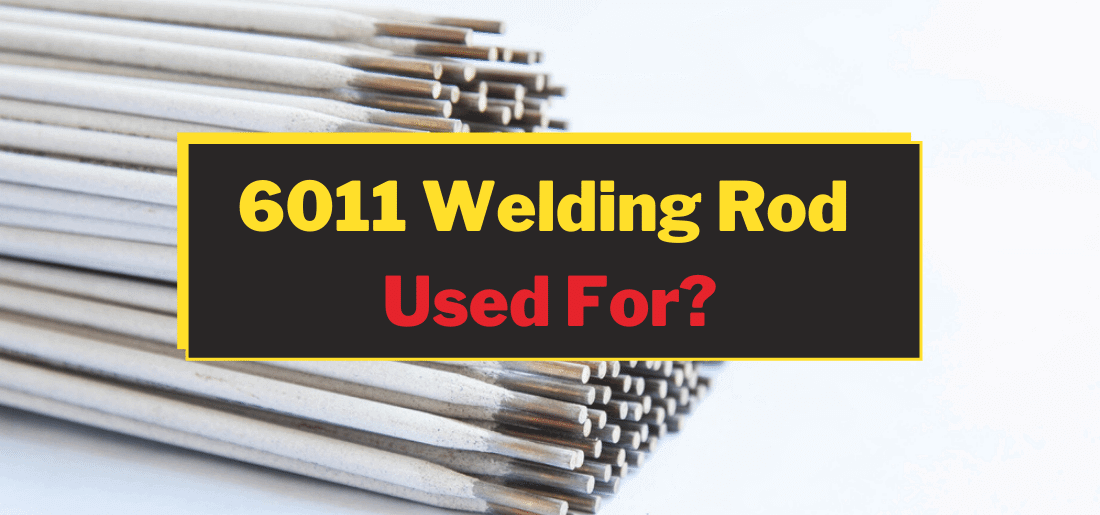Are you wondering how to select a welding rod and if a 6011 welding rod is the right fit for your needs? Let’s get real, it all comes down to if you’re a DIYer or a professional welder.
Quite frankly, stick welding isn’t a very easy task and it requires some experience and skill. Moreover, one should also know about the basics of stick electrodes also known as welding rods.
Having proper knowledge about some important variables like electrode diameter, flux composition, and storage techniques contribute to the selection and performance you’re looking for. Therefore, having at least some basic knowledge will go a long way in minimizing your confusion and ensure that you can select a welding rod that is ideal for the welding-tasks you need it for.
In our guide on what is 6011 welding rod used for we will be arming you with some basic knowledge that will help you determine if it’s a welding-rod that you can use. There are thousands of stick electrodes, although some of the most common ones are 6010, 6011, 6012, and 6013. However, we will be specifically looking at 6011 rods and what it’s good for.
6011 Welding Rod Uses
To deeply understand what is 6011 welding rods used for, we will be exploring how they are useful and we will be also touching points on some of the basics of welding rods.
Learning the Basics of Welding Rods
Before we start learning about what is 6011 welding rod is used for. We should learn the basics of welding and where it’s most commonly used? Arc welding is very commonly used in farming, sea, mining, and construction. Welding requires the use of electrodes which are called welding rods as we have mentioned before, as they are necessary to complete the welding process.
How does the welding process work? It’s quite simple and yet a bit technically simultaneously. A welding process requires the passing of electricity through the electrode like the 6011 rods. Electricity needs to pass through the stick electrode directly into the metal that is being welded, which in result creates an electrical arc that is cable of reaching a temperature of approximately 5,000 Celcius.
It’s the electrical arc that melts the electrode in conjunction with the base metal to complete the welding process. This process is true for 6011 electrodes and 6013 rods as well.
Learning the Usefulness of 6011 Rods
Here’s an interesting fact related to the welding rods, the numbers designated might seem random, although they convey real meaning. The numbers of the rod are a technical code that describes and holds certain attributes.
Understanding the number system will enable you to learn the most about the rod itself. The first two digits describe the “tensile strength” of the welding-rod in thousands of pounds. For instance, in a 6011 rod, the “60” lets you know that 60,000 pounds of strength will be in the final weld. The third digit “1” represents in what positions the rod can be used. The number “1” is for an all positions rod. Therefore, a 6011 rod can be welded vertically and horizontally.
Lastly, the last two digits which in this case “11” explain the type of flux coating on the welding rod. What is a flux type? It determines the type of current which will work effectively work with the electrode rode. In a 6011 rod, the number “11” stands for a high-cellulose potassium coating which is useful for all types of current like AC, DC and, DC +.
It’s very important to match the rod with the welder’s capabilities because, if the available current doesn’t work with the rod, the user will not be able to achieve the welding result he’s looking for. Another important thing to take into consideration is that not all fluxes have the same penetration abilities, they vary from flux to flux.
On a 6011 high-cellulose potassium flux is capable of producing very deep penetration into the weld which is quite beneficial a metal that is not pristine is being welded. 6011 rods are good for making repairs on farm equipment, engines, car, and items that are known for being rusty, dirty and, greasy.
Understanding Polarity of 6011 Rods
Now we will learn what polarity is, and how it works when it comes to arc welding. Most often, arc welding is carried out by using direct current and the rod is used as the negative electrode, this is what we call the DC or referred to as straight polarity. However, there might be a situation that requires the rod to be used as a positive electrode, this is what we call a reverse polarity or DC+.
You must’ve heard about AC known as the alternating current which is found in cheap cracker box welders, and it is very useful for welding rusty and dirty stock. Although, some rods work with one or two polarities. When it comes to 6011 rods, they work with all polarities like a cracker box, high-end machine, or DC – which makes the whole welding process easier and give you one less thing to worry about.
Understanding Rod Thickness of 6011 Rods
All welding electrodes have different thicknesses, and some of the most common sizes are 3/32, 5/32, and ⅛ of an inch. Although, there are rods that measure up to ¼ of an inch available too. The general rule of thumb is that the rod diameter is directly proportional to the stock that you’re welding. Hence, the diameter of the rod increases as the thickness of the stock increases.
Since thicker rods provide deeper penetration when dealing with heavy-weighted steel. It’s to be noted that the thicker the rod is the higher the amperage is required when welding. Rods with diameters 3/32 and ⅛ are the most useful as they are the thinnest and can be used for lightweight stock along with small welds. ⅛ of an inch welding rods are the most hand and an all-rounding rod for almost all welding-projects.
On the other hand, 5/32 of inch welding rods are only useful when welding the heaviest of metals that have a thickness of half an inch or larger. Ideally, individuals who are working on home-improvement objects will not need electrode rods with more than half an inch as their scope of work revolves around lightweight metals.
How to Store 6011 Rods?
When it comes to storing 6011 rods the best practice is to store these electrode rods in their original packaging. There are electrodes rods that are prone to damage by the moisture present in air and have to be stored in an oven with a temperature of 250 degrees as soon as they are taken out of their original packaging.
For instance, 7018 along with other specialty rods of cast iron and stainless steel require oven storage. However, 6011 rods can be easily in a dry environment at room temperature. Although, one should avoid wetting the electrodes at all costs.
When to Avoid 6011 Rods?
Although, 6011 welding rods are quite versatile. A few drawbacks come with them, as they leave a rougher bead in comparison to other electrode rods. Therefore, if you have to achieve a pretty bead, then it’s not the electrode choice, as when making wider fillet welds, the weld is more likely prone to cracking. A slower-cooling is recommended or making two passes when fillet welding is the best way to go about it.
Moreover, as 6011 rods make deep penetrations they are very hard to use with sheet metal as they easily burn holes. For thin stock, choosing another electrode is a better strategy. Besides, 6011 welding rods are hard to control and strike, and most novice welders might struggle to keep the rod from sticking to the bead. However, it should be kept in mind that 6011 rods shouldn’t be used for stainless steel, copper, aluminum, and titanium.
There are other electrode rods you can go for, for instance, if the appearance of a weld is a priority for your welding-work then 7018 electrodes are a better choice as they are known for delivering the smoothest weld.
Final Words
The good thing about 6011 rods is that no matter the kind of welding arc work you need to do they are quite compatible with any welding-tasks. These are very handy especially for welders who have to perform repairs on farm equipment, cars, and materials that are dirty and greasy. Most importantly, 6011 rods are stored at room temperature and can be stocked in quantity without having to worry about them going bad.
Therefore, whether you’re a DIYer or a professional welder, 6011 rods are versatile, an all-rounding option, and don’t require any specific conditions for storage as well.




